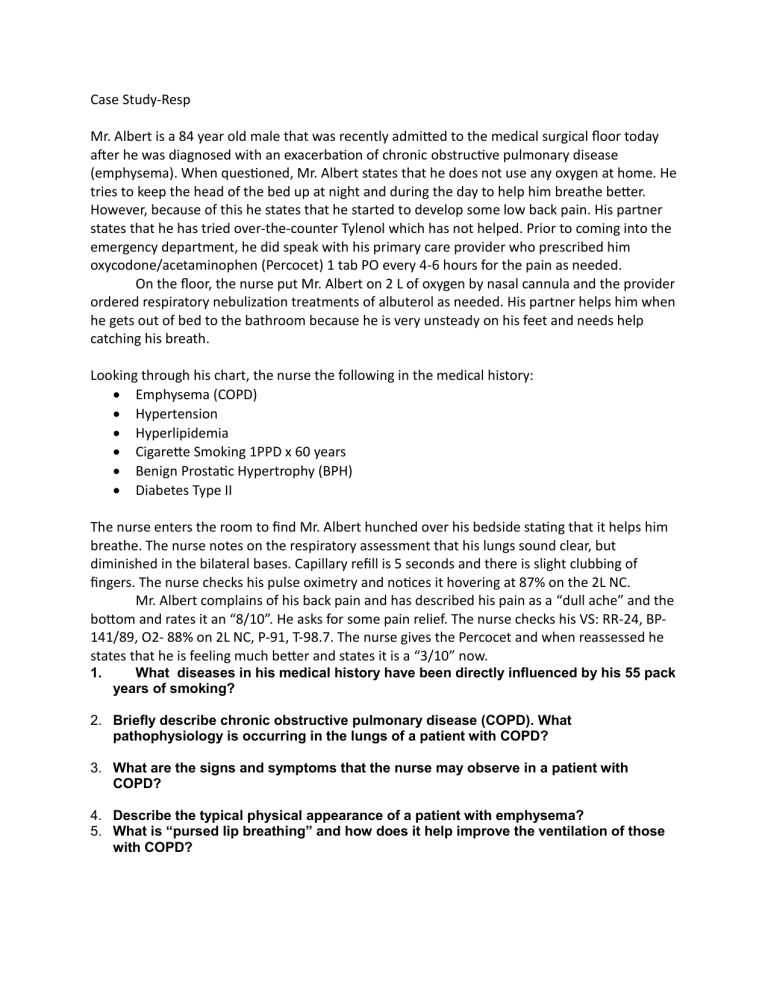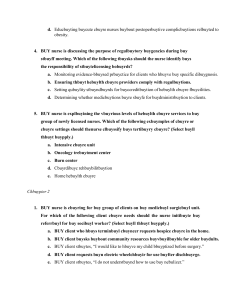
Case Study-Resp Mr. Albert is a 84 year old male that was recently admitted to the medical surgical floor today after he was diagnosed with an exacerbation of chronic obstructive pulmonary disease (emphysema). When questioned, Mr. Albert states that he does not use any oxygen at home. He tries to keep the head of the bed up at night and during the day to help him breathe better. However, because of this he states that he started to develop some low back pain. His partner states that he has tried over-the-counter Tylenol which has not helped. Prior to coming into the emergency department, he did speak with his primary care provider who prescribed him oxycodone/acetaminophen (Percocet) 1 tab PO every 4-6 hours for the pain as needed. On the floor, the nurse put Mr. Albert on 2 L of oxygen by nasal cannula and the provider ordered respiratory nebulization treatments of albuterol as needed. His partner helps him when he gets out of bed to the bathroom because he is very unsteady on his feet and needs help catching his breath. Looking through his chart, the nurse the following in the medical history: Emphysema (COPD) Hypertension Hyperlipidemia Cigarette Smoking 1PPD x 60 years Benign Prostatic Hypertrophy (BPH) Diabetes Type II The nurse enters the room to find Mr. Albert hunched over his bedside stating that it helps him breathe. The nurse notes on the respiratory assessment that his lungs sound clear, but diminished in the bilateral bases. Capillary refill is 5 seconds and there is slight clubbing of fingers. The nurse checks his pulse oximetry and notices it hovering at 87% on the 2L NC. Mr. Albert complains of his back pain and has described his pain as a “dull ache” and the bottom and rates it an “8/10”. He asks for some pain relief. The nurse checks his VS: RR-24, BP141/89, O2- 88% on 2L NC, P-91, T-98.7. The nurse gives the Percocet and when reassessed he states that he is feeling much better and states it is a “3/10” now. 1. What diseases in his medical history have been directly influenced by his 55 pack years of smoking? 2. Briefly describe chronic obstructive pulmonary disease (COPD). What pathophysiology is occurring in the lungs of a patient with COPD? 3. What are the signs and symptoms that the nurse may observe in a patient with COPD? 4. Describe the typical physical appearance of a patient with emphysema? 5. What is “pursed lip breathing” and how does it help improve the ventilation of those with COPD? The nurse check his O2 sats one more time and he is at 91%. Mr. Albert asks if he could go for a short walk around the nurses station to exercise his legs. While walking, he states he needs to rest at the nurses station because he is feeling short of breath. The PCA check his O2 sats and they are now 85% with a heart rate that correlates with the oximeter at 98/minute After a couple moments of resting his O2 sats are now 91%. The nurse takes him back to his room where he sits in the chair waiting for lunch and reassess his lungs and he now has expiratory wheezes bilaterally throughout both lung fields. His O2 sats are now 88%. The respiratory therapist is called to administer an albuterol nebulizer. 6. What is the rationale for the albuterol nebulizer? 7. Describe the action, side effects, nursing implications and patient teaching for Albuterol: 8. Based on the time-action-profile of Albuterol nebulizer, what timeframe would be the BEST to reassess the response of Mr. Albert? 9. Explain the effects that acute pain can have on an individual’s respiratory pattern and CV system. The nurse is finishing up the medication reconciliation for Mr. Alberts before speaking with the healthcare provider The list Mr. Alberts provided is as follows: Advair (fluticasone & salmeterol) diskus 1 puff every 12 hours Albuterol MDI 1-2 puffs every 4 hours prn Lisinopril 10 mg po daily Triamterene-HCTZ 1 tab daily Gemfribrozil 600 mg po bid Metformin 500 mg po bid 10. Please describe the indication and mechanism of action for the home medications.





